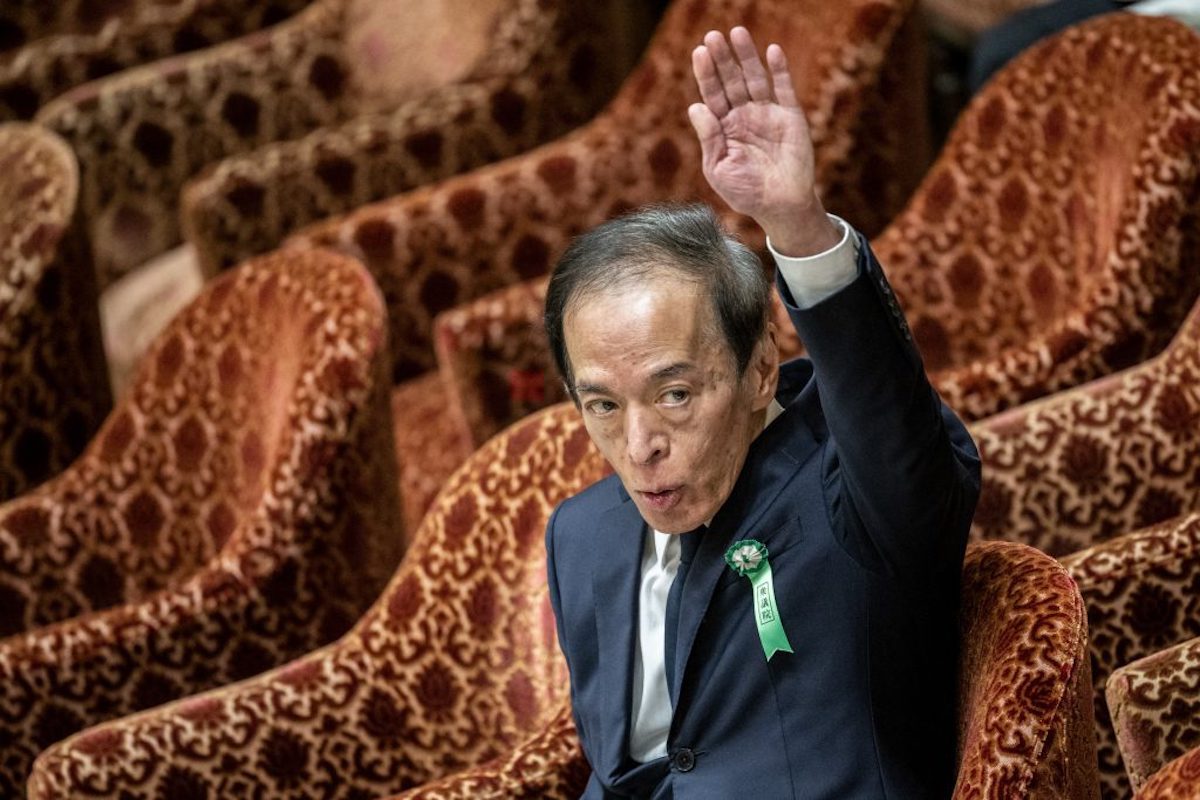Global Courant 2023-04-27 16:42:17
TOKYO – Judging by the lack of volatility in yen trading, investors are not expecting any fireworks from the Bank of Japan tomorrow (April 28).
Of course, surprises happen at BOJ headquarters. But given that this is Kazuo Ueda’s first policy meeting as governor, it is unlikely that Tokyo is about to shock global markets with a reversal in its more than 20-year experiment with quantitative easing.
That would make sense given the worrying mix of issues bubbling up beneath the surface of the world’s third-largest economy. Those include concerns about a Silicon Valley Bank-like blowout among Japan’s more than 100 regional lenders.
Another: the high likelihood of a political backlash in Tokyo if Ueda were to implement radical monetary policies.
This last point is often undervalued in analyzes of the BOJ’s latitude to take risky moves. While the BOJ is “independent,” it is in reality on a shorter leash than many observers care to admit. Case in point: Haruhiko Kuroda left the BOJ governorship earlier this month with no qualms about winding down QE.
Granted, the BOJ had been deep in the QE matrix for 13 years by the time Kuroda arrived in 2013. But he changed the Japanese QE era to 11 and then some. And with limited success, obviously, as wages stabilized amid record corporate profits from a plummeting yen.
Still, the large gains in Nikkei stocks and relative macroeconomic stability provided Kuroda with considerable political capital domestically. Capital he could have spent as he went out the door trying to figure out ways to reduce the BOJ’s $5 trillion balance sheet.
Kuroda did not, leaving Ueda with arguably the worst job in the global economy. As Ueda leads his first policy deliberation as governor, memories of December 20, 2022 loom.
The outgoing governor of the Bank of Japan, Haruhiko Kuroda. Photo: AFP/Jiji Press
All hell broke loose on the markets that day after Team Kuroda announced the slightest adjustments to its yield curve control policy. The move to raise 10-year bond yields to 0.5% was designed to narrow the gap between US and Japanese interest rates. That, Kuroda thought, would ease the pressure on the BOJ to intervene in markets day in and day out.
Kuroda’s BOJ spent the next two weeks cleaning up the mess of the move by making numerous unplanned asset purchases to reassure global investors that QE is here to stay.
Then came the Silicon Valley Bank crisis in the US. Next, UBS had to bail out Credit Suisse, which served to raise global paranoia levels to the next level.
Now comes the news this week that San Francisco-based First Republic Bank’s troubles are far from over. And it follows that worries about new bank failures are increasing day by day.
This is the environment of limited options that Ueda steps into. Reports from Bloomberg that US regulators may be downgrading First Republic’s outlook are making headlines as Ueda sits down to consider BOJ policy. It’s also worth noting that Japan’s economic performance so far in 2023 hasn’t been great.
“While the recent fall in government bond yields seems to open the door for yield curve management adjustments, such a move could backfire,” said economist Stefan Angrick of Moody’s Analytics. “The recent economic data has not been good. Disappointing GDP growth means the economy is still smaller than before the pandemic. Working conditions are showing signs of weakening and wage growth is lagging inflation.”
To complicate matters, recent ‘shunto’ wage negotiations yielded the largest wage increase since 1993 – an average of 3.8%. The problem is that, amid the highest inflation in 40 years, the timing of wage increases may increase risks of overheating. Here, China’s recovery adds to the risk of a second wind for global inflation.
As Angrick points out, “despite a strong wage round in the spring, it is unclear whether this year’s gains will be repeated next year. Recent disruptions in the financial markets abroad have only increased the risk. Given the history of premature policy tightening by the BoJ, the failed adjustment of yield curve controls in December, and the cold water that poured over the idea of a change at the first press conference with the new leadership of the BOJ, it is unlikely that the BOJ will soon to move house.
The reference here to wage uncertainties for next year deepens the plot for Ueda. On the one hand, the new governor does not want to drive inflation even further. On the other hand, Tokyo’s political establishment would strike if BOJ’s “tapering” scared CEOs into closing their wallets again.
As Naoko Tochibayashi, an analyst at the World Economic Forum in Tokyo, points out, even now it remains to be seen whether similar wage increases can be seen in small and medium-sized enterprises, which make up 70% of employers and are key to economic growth from Japan. revival.”
Japanese workers negotiate higher wages. Photo: AFP/Charly Triballeau
This dramatizes the precarious balancing act facing Ueda. So is the fragile state of Japan’s regional banking network. Many of these lenders serve rapidly aging communities in already sparsely populated areas of the country. That depressed earnings well before the banking shocks of the past 15 years, including the aftermath of the 2008 “Lehman shock.”
That episode, aging customer bases and an accelerated corporate exodus to Tokyo caused regional banks to hoard government and corporate bonds rather than lend BOJ liquidity. It was a similar practice that blew up the SVB and New York-based Signature Bank.
At the end of December, SMBC Nikko Securities estimated that regional lenders were sitting on about $10.5 billion in unrealized losses on foreign bonds and other securities. Such numbers raise a difficult question that Ueda must now answer: How big could domestic debt losses be if Japanese government bond yields were to rise above, say, 1% or more?
The good news is that many Japanese banks prefer bonds that can be sold rather than holding SVB-style bonds to maturity. As such, SMBC Nikko analyst Masahiko Sato estimates that the threat to capital ratios averages only about 2%. Therefore, Sato “doesn’t think potential losses are on a scale with systemic implications.”
BOJ tapering or even a few rate hikes could change this calculation, and fast. If regional banks face profit pressure with rates at zero — and the BOJ is still in 24/7 ATM mode — imagine the valuation losses if Ueda were to hit the monetary brake.
Still, Ueda’s pedigree suggests he could be more of an out-of-the-box thinker than understanding currency strategists.
During his time as a BOJ board member in 2000, Ueda disagreed over an effort to end the zero-rate strategy. His background as a Massachusetts Institute of Technology-trained economist, meanwhile, could be its own wild card.
At MIT, Ueda was a student of Stanley Fischer, a former senior official at the Fed, the Bank of Israel, and the International Monetary Fund. Fisher also taught former Fed chief Ben Bernanke, former European Central Bank chief Mario Draghi, and former Treasury Secretary Lawrence Summers.
Other members of MIT’s monetary club include Reserve Bank of Australia Governor Philip Lowe and former Bank of England Governor Mervyn King.
In February, Summers called Ueda “Ben Bernanke from Japan.” It is worth noting that Ueda and Bernanke built their economic reputation by examining the lessons of the Great Depression, including Japanese policies from the late 1920s to the mid-1930s.
For Ueda, that meant a sharp focus on the policies of Korekiyo Takahashi of the 1930s, often referred to as Japan’s John Maynard Keynes.
Kazuo Ueda has arguably the toughest job in finance as the next governor of the Bank of Japan. Image: Facebook/Asahi/Screengrab
Takahashi served as finance minister, BOJ governor and even prime minister in the 1920s and 1930s. His super-aggressive monetary easing, fiscal expansion, and “debt monetization” efforts were as groundbreaking as economic policy can get.
There is also reason to believe that Ueda could be a rather conventional central banker. For example, he has so far said there is no urgency to change the BOJ government framework that imposes a 2% inflation target on the central bank.
“Ueda is likely to ask the government to revise the joint statement if necessary to allow the BOJ to respond flexibly, without committing to the continuation of monetary easing,” said JPMorgan Chase & Co-Economist Benjamin Shatil. “We continue to see an exit from yield curve control in the coming months.”
Still, the odds are decidedly slim that tomorrow (April 27) Ueda would choose to throw financial explosives into jittery markets. And that seems sensible for now.
Follow William Pesek on Twitter at @William Pesek
Similar:
Loading…








